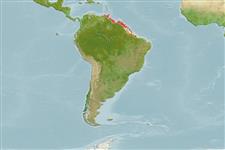Common names from other countries
Elasmobranchii (tubarões e raias) (sharks and rays) >
Carcharhiniformes (Ground sharks) >
Carcharhinidae (Requiem sharks)
Etymology: Isogomphodon: iso-, from isos (Gr.), equal; gomphos (Gr.), nail; odon (Gr.), tooth, referring to how teeth are equally fastened, i.e., claviform and straight in both jaws. (See ETYFish); oxyrhynchus: oxys (Gr.), sharp; rhynchus (L.), snout, referring to its elongated, pointed and narrow snout [authorship often attributed to Müller & Henle, who published Valenciennes’ description]. (See ETYFish).
Environment: milieu / climate zone / depth range / distribution range
Ecologia
marinhas; estuarina demersal; intervalo de profundidade ? - 15 m (Ref. 13608). Tropical; 12°N - 20°S, 63°W - 34°W (Ref. 244)
Western Atlantic: Trinidad, Guyana, Suriname, French Guiana, and Brazil.
Comprimento de primeira maturação / Tamanho / Peso / Idade
Maturity: Lm 115.0 range ? - ? cm
Max length : 160 cm TL macho/indeterminado; (Ref. 34266); common length : 100.0 cm TL macho/indeterminado; (Ref. 5217); idade máx. registrada: 12 anos (Ref. 34266)
Large number of teeth, great length of very narrow snout. Yellow-gray above and white below (Ref. 6032).
An inshore shark found over rocky bottoms, entering estuaries and river mouths. Feeds on small schooling fishes including herring, anchovies and croakers. Viviparous, generally 4 embryos per brood; size at birth 38 to 41 cm. 244 cm record unconfirmed.
Distinct pairing with embrace (Ref. 205). Viviparous, placental (Ref. 50449).
Compagno, L.J.V., 1984. FAO Species Catalogue. Vol. 4. Sharks of the world. An annotated and illustrated catalogue of shark species known to date. Part 2 - Carcharhiniformes. FAO Fish. Synop. 125(4/2):251-655. Rome: FAO. (Ref. 244)
Status na Lista Vermelha da UICN (Ref. 130435)
Uso pelos humanos
Pescarias: pesca de subsistência
Mais informação
ReferênciasAquaculturaPerfil para aquaculturaEstirpesGenéticaElectrophoresesHereditariedadeDoençasProcessamentoConversão de massa
ColaboradoresFotosStamps, Coins Misc.SonsCiguateraVelocidadeTipo de nataçãoÁrea branquialOtólitosCérebrosVisão
Ferramentas
Relatórios especiais
Baixar XML
Fontes da internet
Estimates based on models
Preferred temperature (Ref.
115969): 27 - 27.8, mean 27.5 (based on 149 cells).
Índice de diversidade filogenética (Ref.
82804): PD
50 = 1.0000 [Uniqueness, from 0.5 = low to 2.0 = high].
Bayesian length-weight: a=0.00468 (0.00218 - 0.01003), b=3.09 (2.92 - 3.26), in cm Total Length, based on LWR estimates for this (Sub)family-body shape (Ref.
93245).
Nível Trófico (Ref.
69278): 4.5 ±0.80 se; based on food items.
Resiliência (Ref.
120179): Muito baixo(a), tempo mínimo de duplicação da população maior que 14 anos (K=0.11-0.12; tm=5-7; tmax=12; Fec=4).
Fishing Vulnerability (Ref.
59153): High to very high vulnerability (74 of 100).
